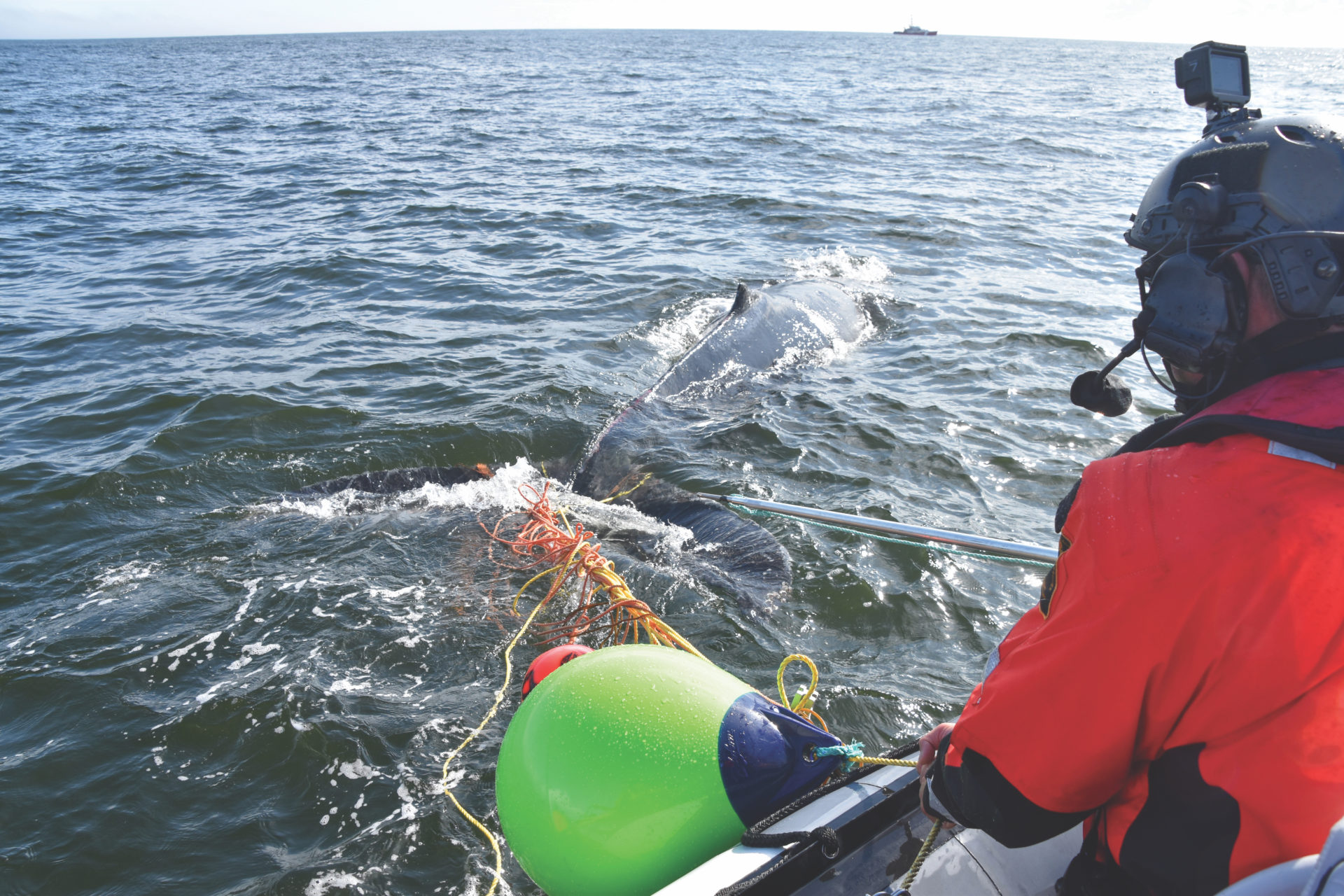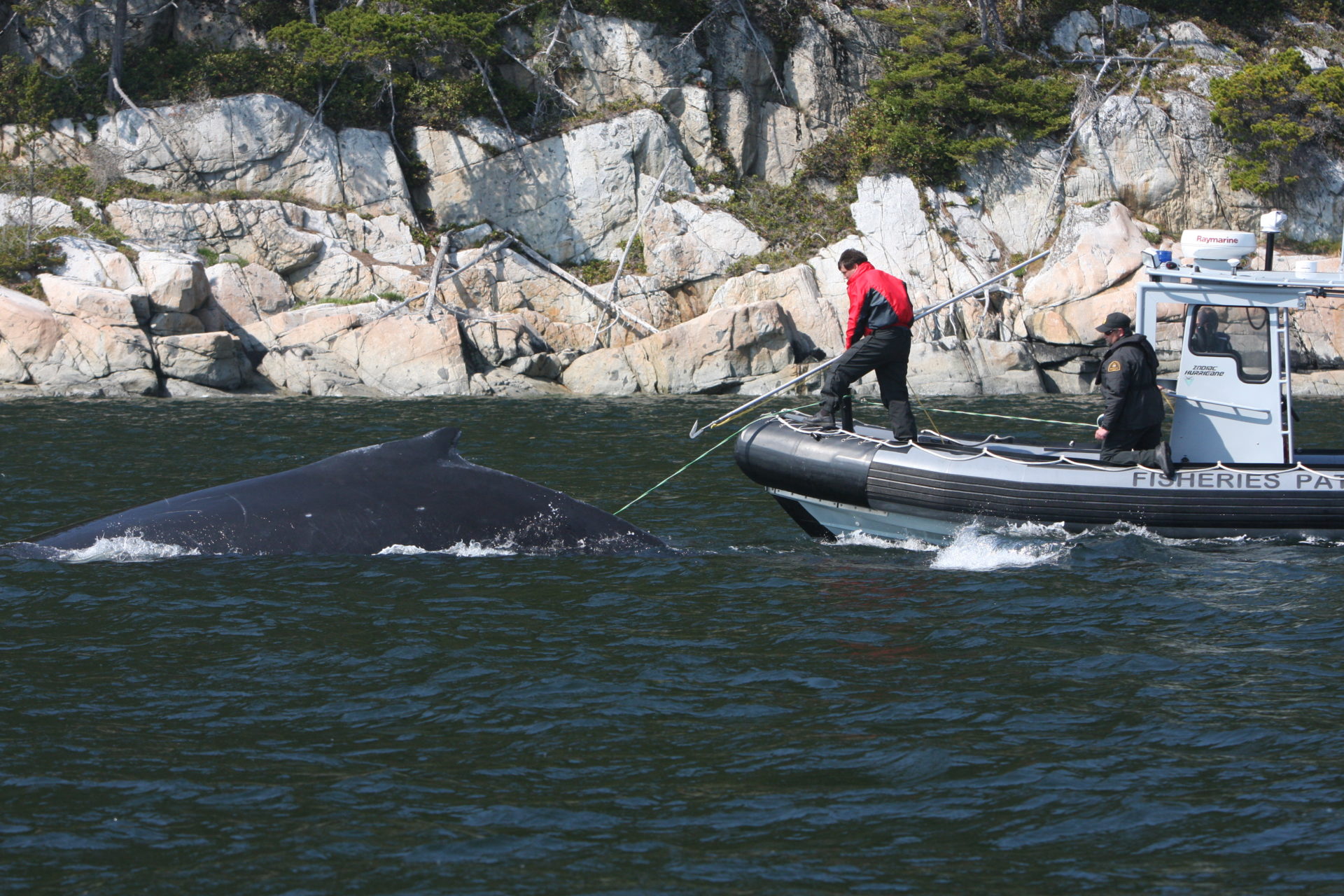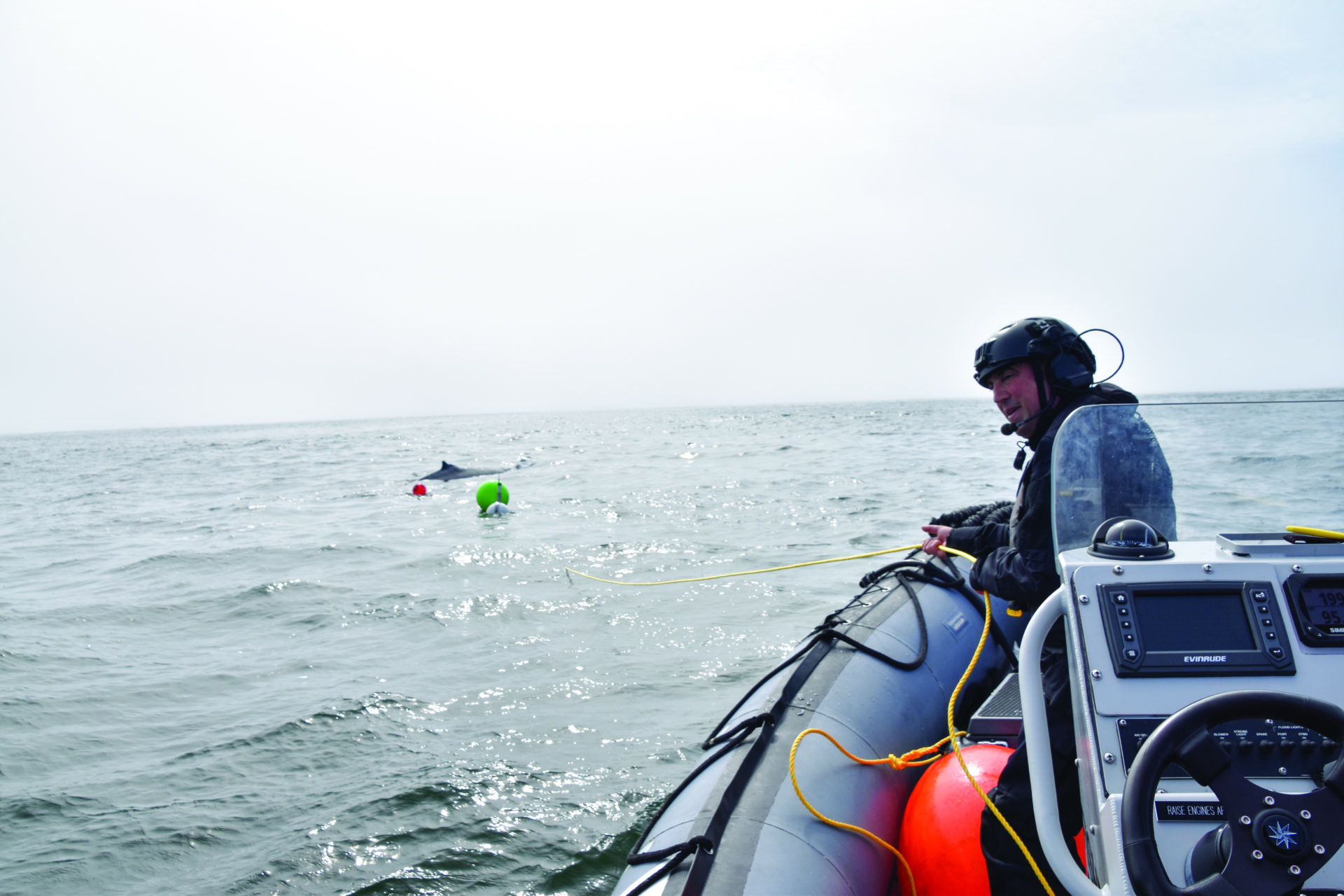The VHF radio call comes early in the morning. “I’ve spotted a mother humpback with a young one who’s dragging a bunch of nets or something,” the excited sport fisherman says. Immediately afterwards, the Coast Guard makes a call to the Marine Mammal Incident Reporting Hotline, the centre that manages reports on whale and other marine animal entanglements. In turn, the hotline quickly reaches Paul Cottrell, British Columbia’s only certified whale disentangler. In less than two hours after the sighting, a floatplane deposits Paul and his gear in Barkley Sound, on Vancouver Island’s west coast.
“Knowing where the humpback is located and getting there are only the first steps of what it takes to dislodge the debris entangling this young whale,” says Paul, a sturdy, highly energetic 52-year-old. “I was lucky this time because fishery officers from Port Alberni’s Department of Fisheries and Oceans (DFO) were already on patrol in the sound. I could jump from the plane onto their rigid-hull inflatable boat (RHIB) and swiftly get to the whales.”
Paul is always in a hurry to reach an entangled whale, but once he arrives, everything slows to a crawl. “We assess the situation and try to figure out how the whale is entangled,” he explains. “Is there a line in its mouth, ropes binding the fins or the fluke? Are crab or prawn traps attached? Is a gillnet wrapped around vital parts? Could the animal be hogtied with lines trussing him from mouth to tail? Is it injured? Often it’s hard to see the entanglement’s configuration when an anxious whale dives and stays down. Patience is key.”
In recent years, technologies designed to help assess an entanglement have evolved. Underwater cameras can reveal how and where the whale is entwined, although they may also frighten the animal. More recently, drones have helped “see” how ropes have snagged the mammal. “We can watch and freeze the drone’s images on the computer, keep our distance and probe the entanglement puzzle before moving in close,” Paul explains.
In Barkley Sound, it’s the tail stock of the one-year-old male humpback that’s trapped. First, Paul and his colleagues carefully and slowly attach a releasable working line to the debris dragging behind the whale, which in turn connects to a float on the RHIB. A satellite buoy with a built-in locator and more buoys are attached to the working line to slow and tire the whale. “We had to watch both the calf and the mother,” says Paul. “The calf was pulling us at about five knots. The mother was agitated and worried about her slowed-down son and our proximity. And remember, the whale may be young, but he’s still 20 feet long and weighs tons.”
Then the really hard work begins. The whale, pulling debris and the RHIB, grows weary. Fortunately, winds are light and the waves insignificant. Bending over the bow and bouncing only a bit, Paul attaches several grapples to the ropes entangling the tail, so that when a line is severed but only partially disentangles the animal, the team can cut away the remaining strings still gnawing at the tail. Paul and his mates use 30-foot carbon poles—with special cutting grapplers—to slice through the tough rope. “As we closed in, we could see the tail had raw, bloody patches,” says Paul. “He’d been dragging this load for quite a while and it had scored his flesh deeply. We worried about infection.”
Five hours after beginning the disentanglement, they cut away the last piece of line. “It was a total of eight wraps,” says Paul. When the last bit of rope lets go, the whale swims free, apparently as relieved as Paul who’s been pitched over the RHIB’s pontoons for hours. “After a disentanglement, I’m sore for days,” he says.
“Sawing away at the last 20 feet is the most dangerous portion of the disentanglement because the lead cutter is closest to the animal, who may sense being freed soon and take off,” Paul explains. “It’s a high adrenaline, high energy job, yet you must remain calm. But it’s absolute euphoria once you’ve successfully liberated a whale.”
Despite the joy the team feels at freeing the young whale, the job isn’t complete. They must fish out the trash the whale has been dragging. Later analysis shows it’s a bundle of three commercial crab traps from Washington State. “The first was single line with a trap, but the other two were all balled up,” says Paul. “We don’t know if the first trap attached to the others while afloat or if the whale picked up the first and then caught the two bundled traps. But we know there was lots of line, lots of drag. The whole thing weighed hundreds of pounds squeezing into that poor tail. The good news is that the calf was seen a year later, in good health but with a big scar.”

“The best job in the world.” This is how Paul describes his whale disentangling profession, one he seemingly has been preparing for from childhood. Growing up on Salt Spring Island, he got an early taste for the sea from his log salvage, beachcomber father. From there, he naturally progressed to earning bachelor’s and master’s degrees in marine biology at Simon Fraser and the University of Victoria respectively. All his co-op terms were spent in nautical environments. During one co-op, he worked with Michael Bigg, the founder of modern research on killer whales, and orca specialist Graeme Ellis. “I was lucky to work with Graeme Ellis,” he says. “He taught me a lot on how to work safely and effectively with marine mammals in the field.”
After graduating, he joined Fisheries and Oceans Canada (DFO) full time and has performed many tasks since. “I started with poop-scooping,” he says (collecting scat for analysis of what seals and sea lions eat). “I got my early training in catching and releasing marine mammals by attaching radio tags to seals to record their diving depths and foraging behaviour.”
He served as “fish cop” monitoring fisheries openings and closings, and as policy coordinator for whale watching fleets. He teaches Indigenous groups—they’re frequent entangled whale spotters—how to attach a satellite buoy that’ll track an animal dragging debris, as well as safe boat handling near the leviathan.
He’s been the marine mammal coordinator since 2007. “For the large whale rescues, I learned by doing,” Paul says. “There was no one from DFO before me who led whale rescues, because entanglements were much less common 15 to 20 years ago.
“I fluked into the work,” he says rolling his eyes at his pun.
Paul is adamant the public should never attempt any aspect of disentanglement. He cites YouTube videos that show guys diving into the water and singlehandedly cutting away lines. “It’s extremely dangerous,” he says. “We never enter the water. An amateur can get tangled up himself and drown, or a frightened animal can drown him. The right equipment is crucial. We have gear packs with helmets, various knives, grapplers with blade attachments, long carbon poles, buoys, drones, GoPro cameras. We attach satellite buoys that can track the whale if it takes off. We stash gear in several places around BC for quick access. And we have patience and long experience.”
Even with experience, whale disentangling is risky. Paul describes the death of Joe Howlett, a long-term expert whale disentangler who, in the Gulf of St. Lawrence last year, was smashed by the tail of a right whale moments after Howlett had freed the lines enmeshing the animal. Howlett died from blunt-force trauma; the accident reverberated throughout the marine-mammal expert community.
He also tells me a tale of how an (un)helpful powerboater hindered a rescue. A Makah research trip near Neah Bay, in Washington State, had spotted an entangled grey whale; they’d attached a VHF transmitter to track its travels. It moved north to Vancouver Island. Paul got the call and hopped on a floatplane to Vancouver Island’s west coast.
Suddenly, the VHF signal remained stationary. Near Nitinat, a recreational boater catching sight of the whale and thinking the buoy distressed it, had cut off the device. Luckily, a Parks Canada crew located the grey whale and the same powerboater rushed Paul to the site. The whale’s tail had become trapped by fishing gear of Japanese origin. “The lines had floats so degraded we think the animal had been lugging the rubbish around for years,” says Paul. “It had 20 wraps around its tail. You can imagine how the animal turned and twisted to rid itself of the debris, but only wound it further. We were incredibly relieved to be able to amputate all those lines. Like the humpback calf, we had sightings of this grey whale later and it was moving well. But this episode shows that people’s best intentions—cutting the buoy—could have led to a whale’s continued suffering or even death.”

Not all whale disentanglements are successful. In 2018, 35 entangled marine mammal reports were filed, with 19 confirmed. Paul and his colleagues disentangled seven humpbacks and two orcas, with a few partial extrications. The others were never found. “They may have moved out far into the Pacific,” says Paul. “They might have managed to disentangle themselves. Or they drowned because they were too entangled, too far gone.”
One whale was liberated twice in three weeks. Paul was in Robson Bight, on northeastern Vancouver Island, on a research trip in a RHIB when he heard the VHF radio crackle. “It’s a beeg, beeg feesh, caught here,” said the prawn fisherman in broken English, in whose traps the young male humpback was ensnared. Paul sped across the strait to Knight Inlet with other DFO personnel, where they found the humpback with a prawn line holding 50 traps caught in its mouth. “It’s a baleen whale,” says Paul. “With that cable through its mouth, it can’t filter feed and it’ll starve. These prawn traps are tied together creating a train of several hundred metres. We worked from the back toward the whale and were able to remove seven traps.
“But it grew dark and we didn’t have a satellite tag—only large buoys to mark the animal,” says Paul. “The whale, nicknamed ‘Twister’ in the Marine Education and Research Humpback Research database, took off. I had the worst sleep of my life worrying that we might not find him again.” Putting out calls on the VHF radio, the team searched for hours until Coast Guard radio notified them of a sighting farther north, in Queen Charlotte Sound. On site, the team again chopped the prawn traps trailing behind the whale one-by-one, until at its mouth, one final cut liberated the whale.
Shockingly, Twister again caught a prawn trap line in its mouth exactly three weeks later. “He’d returned to his foraging in Knight Inlet,” says Paul. “This time he was anchored to the bottom and circling. Again, the call came into the 24-hour marine mammal incident hotline and I took a floatplane hop from Vancouver. DFO personnel had already arrived on site in a RHIB with gear aboard. Twister’s strength brought the traps up near the surface and we could move up the line, severing them one at a time. After many hours, we reached Twister’s mouth and with one final slash, freed him again. He’s been seen regularly since and is faring well.”
Paul is a member of the International Whaling Commission’s Expert Global Whale Entanglement Response Group. This expert group works as a collective to advance safe disentanglement techniques, equipment innovation and training methods to effectively and safely disentangle large whales. The group shares what they’ve learned from their disentanglement successes and failures to minimize marine mammal entanglements around the world.
“Although this is the best job in the world,” says Paul, “our eventual goal is to eliminate it, to literally work ourselves out of a job.”


